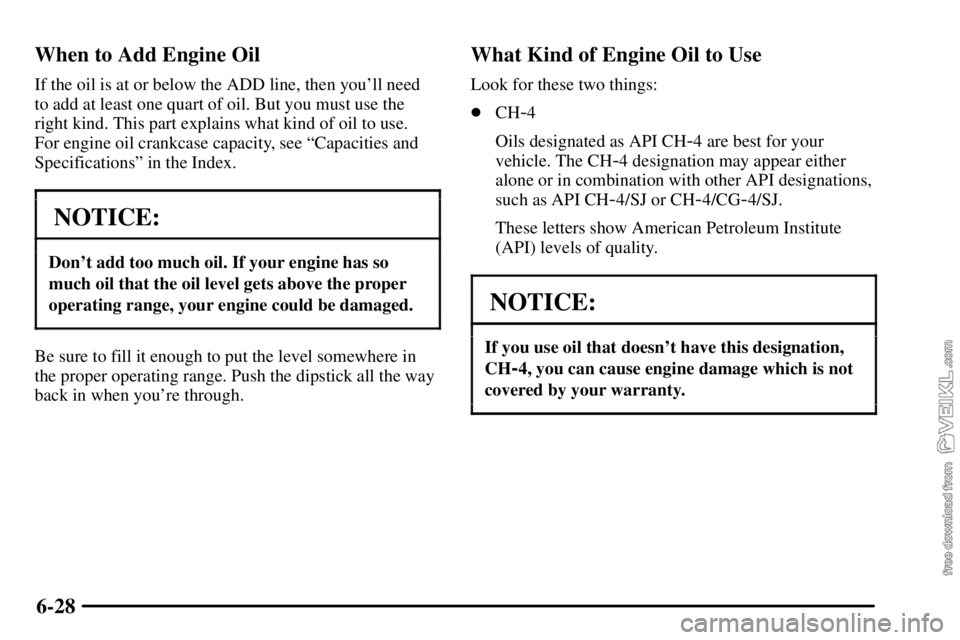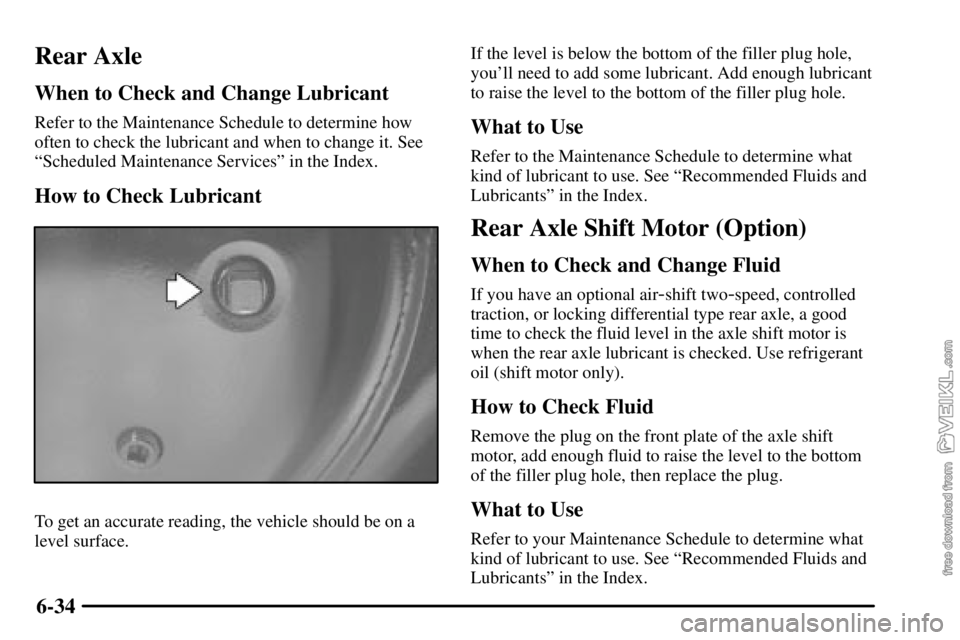Page 276 of 386
6-22 Checking Engine Oil
It's a good idea to check your engine oil every time you
get fuel. In order to get an accurate reading, the oil must
be warm and the vehicle must be on level ground.
The engine oil dipstick
is located in the engine
compartment on the
driver's side of the vehicle.
Turn off the engine and give the oil several minutes to
drain back into the oil pan. If you don't, the oil dipstick
might not show the actual level.Pull out the dipstick and clean it with a paper towel or
cloth, then push it back in all the way. Remove it again,
keeping the tip down, and check the level.
Page 277 of 386
6-23 When to Add Engine Oil
If the oil is at or below the cross-hatched area, then
you'll need to add at least one quart of oil. But you must
use the right kind. This part explains what kind of oil to
use. For engine oil crankcase capacity, see ªCapacities
and Specificationsº in the Index.
NOTICE:
Don't add too much oil. If your engine has
so much oil that the oil level gets above the
cross
-hatched area upper mark that shows
the proper operating range, your engine could
be damaged.
The engine oil fill cap is
located near the engine oil
dipstick in the engine
compartment, on the
driver's side of the vehicle.
Be sure to fill it enough to put the level somewhere in
the proper operating range. Push the dipstick all the way
back in when you're through.
Page 279 of 386

6-25
As in the chart shown previously, SAE 5W-30 is best for
your vehicle. However, you can use SAE 10W
-30 if it's
going to be 0�F (
-18�C) or above. These numbers on
an oil container show its viscosity, or thickness. Do not
use other viscosity oils, such as SAE 20W
-50.
NOTICE:
Use only engine oil with the American Petroleum
Institute Certified For Gasoline Engines
starburst symbol. Failure to use the
recommended oil can result in engine damage not
covered by your warranty.
GM Goodwrench� oil meets all the requirements for
your vehicle.
If you are in an area where the temperature falls
below
-20�F (-29�C), consider using either an
SAE 5W
-30 synthetic oil or an SAE 0W-30 oil. Both
will provide easier cold starting and better protection for
your engine at extremely low temperatures.
Engine Oil Additives
Don't add anything to your oil. The recommended oils
with the starburst symbol are all you will need for good
performance and engine protection.
When to Change Engine Oil
(GM Oil Life System�)
Your vehicle has a computer system that lets you know
when to change the engine oil and filter. This is based on
engine revolutions and engine temperature, and not on
mileage. Based on driving conditions, the mileage at
which an oil change will be indicated can vary
considerably. For the oil life system to work properly,
you must reset the system every time the oil is changed.
When the system has calculated that oil life has been
diminished, it will indicate that an oil change is
necessary. A change oil light will come on. Change your
oil as soon as possible within the next two times you
stop for fuel. It is possible that, if you are driving under
the best conditions, the oil life system may not indicate
that an oil change is necessary for over a year. However,
your engine oil and filter must be changed at least once
a year and at this time the system must be reset. It is also
important to check your oil regularly and keep it at the
proper level.
If the system is ever reset accidentally, you must change
your oil at 3,000 miles (5 000 km) since your last oil
change. Remember to reset the oil life system whenever
the oil is changed.
Page 281 of 386
6-27
Engine Oil (Caterpillar�
Diesel Engines)
See your Caterpillar� Operation & Maintenance Manual
for information on oil quality and viscosities as well as
the temperature range chart.
Engine Oil (DURAMAX� Diesel)
Checking Engine Oil
It's a good idea to check your engine oil level every time
you get fuel.
The engine oil dipstick is
located in the engine
compartment on the driver's
side of the vehicle.
In order to get an accurate
reading, the oil must be
warm (at normal operating
temperature) and the vehicle
must be on level ground.Turn off the engine and give the oil at least five minutes
to drain back into the oil pan. With a cool engine, allow
30 minutes. If you don't, the oil dipstick might not show
the actual level.
Pull out the dipstick and clean it with a paper towel or a
cloth, then push it back in all the way. Remove it again,
keeping the tip down.
Page 282 of 386

6-28 When to Add Engine Oil
If the oil is at or below the ADD line, then you'll need
to add at least one quart of oil. But you must use the
right kind. This part explains what kind of oil to use.
For engine oil crankcase capacity, see ªCapacities and
Specificationsº in the Index.
NOTICE:
Don't add too much oil. If your engine has so
much oil that the oil level gets above the proper
operating range, your engine could be damaged.
Be sure to fill it enough to put the level somewhere in
the proper operating range. Push the dipstick all the way
back in when you're through.
What Kind of Engine Oil to Use
Look for these two things:
�CH
-4
Oils designated as API CH
-4 are best for your
vehicle. The CH
-4 designation may appear either
alone or in combination with other API designations,
such as API CH
-4/SJ or CH-4/CG-4/SJ.
These letters show American Petroleum Institute
(API) levels of quality.
NOTICE:
If you use oil that doesn't have this designation,
CH
-4, you can cause engine damage which is not
covered by your warranty.
Page 287 of 386
6-33 How to Check and What to Use
Check the fluid level only when your engine is off, the
vehicle is parked on a level place and the transmission is
cool enough for you to rest your fingers on the
transmission case.
Then, follow these steps:
1. Remove the filler plug.
2. Check to be sure that the lubricant level is up
to the bottom of the fill opening. On heavy duty
transmissions (an inch of oil level equals about
one gallon of fluid.)
3. If the fluid level is good, install the plug and be sure
it is fully seated. If the fluid level is low, add more
fluid as described in the next steps.
How to Add Fluid
Here's how to add fluid. Refer to the Maintenance
Schedule to determine the proper fluid to use. See
ªRecommended Fluids and Lubricantsº in the Index.
1. Remove the filler plug.
2. Add fluid at the filler plug hole. Add only enough
fluid to bring the fluid level up to the bottom of the
fill opening.
3. Install the filler plug. Be sure the plug is fully seated.
Page 288 of 386

6-34
Rear Axle
When to Check and Change Lubricant
Refer to the Maintenance Schedule to determine how
often to check the lubricant and when to change it. See
ªScheduled Maintenance Servicesº in the Index.
How to Check Lubricant
To get an accurate reading, the vehicle should be on a
level surface.If the level is below the bottom of the filler plug hole,
you'll need to add some lubricant. Add enough lubricant
to raise the level to the bottom of the filler plug hole.
What to Use
Refer to the Maintenance Schedule to determine what
kind of lubricant to use. See ªRecommended Fluids and
Lubricantsº in the Index.
Rear Axle Shift Motor (Option)
When to Check and Change Fluid
If you have an optional air-shift two-speed, controlled
traction, or locking differential type rear axle, a good
time to check the fluid level in the axle shift motor is
when the rear axle lubricant is checked. Use refrigerant
oil (shift motor only).
How to Check Fluid
Remove the plug on the front plate of the axle shift
motor, add enough fluid to raise the level to the bottom
of the filler plug hole, then replace the plug.
What to Use
Refer to your Maintenance Schedule to determine what
kind of lubricant to use. See ªRecommended Fluids and
Lubricantsº in the Index.
Page 305 of 386
6-51
Tandem Axle Models
ITEM
NO. ITEM REMARKS
1 Brake Camshafts One fitting each.
2
Propshaft U
-JointOne fitting each joint.
Lubricate with
GM Part No. 1051344,
Wheel Bearing Lubricant.
4 Brake Shoe
Roller PinsApply engine oil at pin
to shoe joint only.
5 Rear Spring Pin One fitting each side.
6 Rear Axles Fill to level of filler plug.